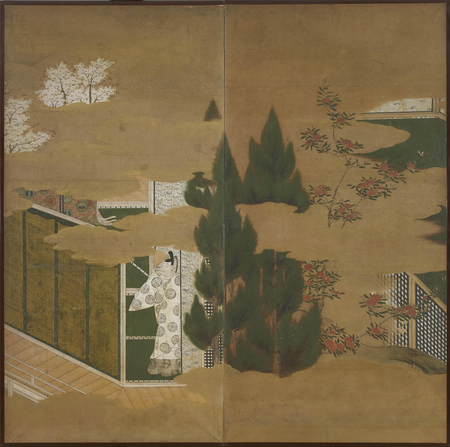Product Description
7710 A two-fold paper screen painted in ink, colour, gold and cut silver leaf, depicting the scene “Yugiri (Evening Mist)” from the Tale of Genji
Japan, 17th century, Edo period
Dimensions: H. 170.5 cm x W. 172 cm (67¼” x 67¾”)
The title of chapter 39, Yugiri (literally means Evening Mist), is taken from its protagonist Yugiri, the eldest son of Hikaru Genji, and its main theme is Yugiri’s unrequited love for the Second Princess Ochiba (lit. Fallen Leaves).
In the autumn of his 29th year Yugiri visited a villa where Ochiba and her unwell mother Lady Ichijo had moved to, under the pretext of checking on her mother’s health. Towards sunset a heavy mist started to rise and cover the coloured autumn leaves on the hillside. Seeing the evening mist which obscured his pathway home and wishing to spend a night there with Ochiba, Yugiri sent her a poem:
Yamazato no
aware wo souru yugiri ni
Tachiidemu sora mo naki kokochi shite
At this villa in a mountain base
the evening mist that deepens one’s sentiment and sorrows
prevents me from leaving this place
The Tale of Genji (Genji Monogatari) was written over 1,000 years ago by a lady-in-waiting at the Heian Imperial court known as Lady Murasaki (978-1016). A monumental work of literature consisting of 54 chapters (over 1,000 pages of text in its English translation) is composed of mini-sagas in the life and romances of the Prince Hikaru Genji and two generations of his descendants. This tour de force of literature is generally considered to be the world’s first true novel, and certainly the first psychological novel ever written with a true sense of interiority.
The influence of the Tale of Genji is unprecedented. The aristocrats depicted in the tale were the objects of admiration throughout the history of Japanese literature – a group of noble elites renowned for their fine clothing, sensitivity to the beauty of nature as well as being accomplished at poetry, music and calligraphy. The idealised characters, in particular Genji, were the quintessential manifestation of the aristocratic ideals and sensibility of the Heian period (794-1185). However they also attracted the readers’ sympathy as they had flaws and weaknesses that anyone could relate to. The Tale of Genji soon became the source of cultural education and refinement for nobles from the Kamakura period (1185-1333) onwards and was a rich source of inspiration for artists – the characters and the scenes from the tale were popular subjects for screen and scroll paintings over the centuries in Japan.









